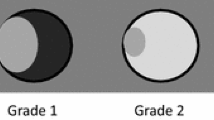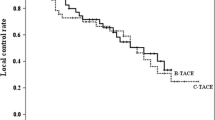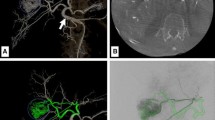Abstract
Purpose
The purpose of this study was to analyze the intrahepatic perfusion redistribution after embolization of hepatic arterial variants during percutaneous arterial port catheter placement as well as to investigate the treatment efficacy of intraarterial chemotherapy in perfusion redistribution-dependent compared to redistribution-independent liver areas.
Materials and Methods
This retrospective study included 62 patients (67.7% males, mean age of 56 ± 12 years). A replaced left hepatic artery was encountered in 36/62 (58.1%), a replaced right hepatic artery in 19/62 (30.6%) and a replaced left and right hepatic artery in 7/62 of patients (11.3%), respectively. Subjective perfusion analysis was performed on digital subtracted angiography and computed tomography (CT)/cone-beam computed tomography (CBCT) images evaluating the visibility of the main, segmental and subsegmental branches of the embolized variant hepatic artery, re-perfused from intrahepatic arterial anastomoses. For objective perfusion analysis ROI measurements on CT/CBCT images were taken in the redistribution-dependent and redistribution-independent liver lobe. Response analysis according to RECIST 1.1 was separately calculated for the redistribution-dependent and redistribution-independent liver lobe.
Results
Intrahepatic reperfusion of the embolized variant hepatic artery was observed immediately after embolization with visualization of the subsegmental branches in 95.2% of patients. ROI measurements on CT/CBCT images (right lobe mean 76 ± 30.2 HU, left lobe mean 74.4 ± 30.5, p-value 0.88) did not show any differences. Treatment response after intraarterial chemotherapy did not differ between the redistribution-dependent and redistribution-independent liver lobes.
Conclusion
Embolization of hepatic arterial variants during percutaneous arterial port catheter placement results in effective intrahepatic perfusion redistribution and does not compromise treatment efficacy of intraarterial chemotherapy in the redistribution-dependent liver lobe.





Similar content being viewed by others
Abbreviations
- AE:
-
Adverse event
- CT:
-
Computed tomography
- CBCT:
-
Cone-beam computed tomography
- DSA:
-
Digital subtraction angiography
- HAIC:
-
Hepatic arterial infusion chemotherapy
- HU:
-
Hounsfield unit
- MRI:
-
Magnetic resonance imaging
- ROI:
-
Region of interest
- SPECT:
-
Single-photon emission computed tomography
References
Kwan J, Pua U. Review of intra-arterial therapies for colorectal cancer liver metastasis. Cancers. 2021;13:1371.
Zhao JJ, Tan E, Sultana R, Syn NL, Zhuang KD, Leong S, et al. Intra-Arterial therapy for unresectable colorectal liver metastases: a meta-analysis. J Vasc Interv Radiol. 2021;32:1536-1545.e38.
Chapelle N, Matysiak-Budnik T, Douane F, Metairie S, Rougier P, Touchefeu Y. Hepatic arterial infusion in the management of colorectal cancer liver metastasis: current and future perspectives. Digest Liver Dis. 2018;50:220–5.
Boilève A, Maillard A, Wagner M, Dromain C, Laurent C, Bierre ED, et al. Treatment intensification with hepatic arterial infusion chemotherapy in patients with liver-only colorectal metastases still unresectable after systemic induction chemotherapy: a randomized phase II study–SULTAN UCGI 30/PRODIGE 53 (NCT03164655)-study protocol. BMC Cancer. 2020;20:74.
Pernot S, Pellerin O, Mineur L, Monterymard C, Smith D, Lapuyade B, et al. Phase III randomized trial comparing systemic versus intra-arterial oxaliplatin, combined with LV5FU2 +/- irinotecan and a targeted therapy, in the first-line treatment of metastatic colorectal cancer restricted to the liver (OSCAR): PRODIGE 49. Digest Liver Dis. 2022;54:324–30.
Goéré D, Pignon J-P, Gelli M, Elias D, Benhaim L, Deschamps F, et al. Postoperative hepatic arterial chemotherapy in high-risk patients as adjuvant treatment after resection of colorectal liver metastases - a randomized phase II/III trial–PACHA-01 (NCT02494973). BMC Cancer. 2018;18:787.
Deschamps F, Elias D, Goere D, Malka D, Ducreux M, Boige V, et al. Intra-arterial hepatic chemotherapy: a comparison of percutaneous versus surgical implantation of port-catheters. Cardiovasc Inter Rad. 2011;34:973–9.
Favelier S, Germain T, Genson P-Y, Cercueil J-P, Denys A, Krausé D, et al. Anatomy of liver arteries for interventional radiology. Diagn Interv Imaging. 2015;96:537–46.
Michels NA. Newer anatomy of the liver and its variant blood supply and collateral circulation. Am J Surg. 1966;112:337–47.
Spreafico C, Morosi C, Maccauro M, Romito R, Lanocita R, Civelli EM, et al. Intrahepatic flow redistribution in patients treated with radioembolization. Cardiovasc Inter Rad. 2015;38:322–8.
Bilbao JI, Garrastachu P, Herráiz MJ, Rodríguez M, Iñarrairaegui M, Rodríguez J, et al. Safety and efficacy assessment of flow redistribution by occlusion of intrahepatic vessels prior to radioembolization in the treatment of liver tumors. Cardiovasc Inter Rad. 2010;33:523–31.
Ezponda A, Rodríguez-Fraile M, Morales M, Vivas I, Torre MDL, Sangro B, et al. Hepatic flow redistribution is feasible in patients with hepatic malignancies undergoing same-day work-up angiography and yttrium-90 microsphere radioembolization. Cardiovasc Inter Rad. 2020;43:987–95.
Karunanithy N, Gordon F, Hodolic M, Al-Nahhas A, Wasan HS, Habib N, et al. Embolization of hepatic arterial branches to simplify hepatic blood flow before yttrium 90 radioembolization: a useful technique in the presence of challenging anatomy. Cardiovasc Inter Rad. 2011;34:287–94.
Allen PJ, Stojadinovic A, Ben-Porat L, Gonen M, Kooby D, Blumgart L, et al. The management of variant arterial anatomy during hepatic arterial infusion pump placement. Ann Surg Oncol. 2002;9:875–80.
Chuang VP, Wallace S. Hepatic arterial redistribution for intraarterial infusion of hepatic neoplasms. Radiology. 1980;135:295–9.
Yamagami T, Yoshimatsu R, Matsumoto T, Nishimura T. Redistribution of multiple hepatic arteries into a single hepatic artery to perform repeated hepatic arterial infusion chemotherapy. Acta Radiol. 2008;49:513–20.
Meijer TS, Geus-Oei L-F de, Martini CH, Netherlands D of A Leiden University Medical Center, Leiden, the, Tijl FGJ, Netherlands D of ECC Leiden University Medical Center, Leiden, et al. Embolization of variant hepatic arteries in patients undergoing percutaneous hepatic perfusion for unresectable liver metastases of ocular melanoma. Diagn Interv Radiol. 2019;25:451–8.
Ikeda O, Tamura Y, Nakasone Y, Shiraishi S, Kawanaka K, Tomiguchi S, et al. Evaluation of intrahepatic perfusion on fusion imaging using a combined CT/SPECT system: influence of anatomic variations on hemodynamic modification before installation of implantable port systems for hepatic arterial infusion chemotherapy. Cardiovasc Inter Rad. 2007;30:383–91.
Burke D, Earlam S, Fordy C, Allen-Mersh TG. Effect of aberrant hepatic arterial anatomy on tumour response to hepatic artery infusion of floxuridine for colorectal liver metastases. Brit J Surg. 1995;82:1098–100.
Lévi FA, Boige V, Hebbar M, Smith D, Lepère C, Focan C, et al. Conversion to resection of liver metastases from colorectal cancer with hepatic artery infusion of combined chemotherapy and systemic cetuximab in multicenter trial OPTILIV. Ann Oncol. 2016;27:267–74.
Arai Y, Takeuchi Y, Inaba Y, Yamaura H, Sato Y, Aramaki T, et al. Percutaneous catheter placement for hepatic arterial infusion chemotherapy. Tech Vasc Interv Radiol. 2007;10:30–7.
Eisenhauer EA, Therasse P, Bogaerts J, Schwartz LH, Sargent D, Ford R, et al. New response evaluation criteria in solid tumours: revised RECIST guideline (version 1.1). Eur J Cancer Oxf Engl. 1990;2009(45):228–47.
Walker BS, Sutton TL, Eil RL, Korngold EK, Kolbeck KJ, Billingsley KG, et al. Conventional hepatic arterial anatomy? Novel findings and insights of a multi-disciplinary hepatic arterial infusion pump program. Am J Surg. 2021;221:1188–94.
Curley SA, Chase JL, Roh MS, Hohn DC. Technical considerations and complications associated with the placement of 180 implantable hepatic arterial infusion devices. Surgery. 1993;114:928–35.
Rayner AA, Kerlan RK, Stagg RJ, Price DC, Hohn DC. Total hepatic arterial perfusion after occlusion of variant lobar vessels: implications for hepatic arterial chemotherapy. Surgery. 1986;99:708–15.
Sato T, Eschelman DJ, Gonsalves CF, Terai M, Chervoneva I, McCue PA, et al. Immunoembolization of malignant liver tumors, including uveal melanoma, using granulocyte-macrophage colony-stimulating factor. J Clin Oncol. 2008;26:5436–42.
Funding
This study was not supported by any funding.
Author information
Authors and Affiliations
Corresponding author
Ethics declarations
Conflict of interest
The authors declare that they have no conflict of interest.
Consent for Publication
For this type of study consent for publication is not required.
Ethical Approval
For this type of study formal consent is not required.
Informed Consent
For this type of study informed consent is not required.
Additional information
Publisher's Note
Springer Nature remains neutral with regard to jurisdictional claims in published maps and institutional affiliations.
Rights and permissions
Springer Nature or its licensor (e.g. a society or other partner) holds exclusive rights to this article under a publishing agreement with the author(s) or other rightsholder(s); author self-archiving of the accepted manuscript version of this article is solely governed by the terms of such publishing agreement and applicable law.
About this article
Cite this article
Kobe, A., Deschamps, F., Meyblum, L. et al. Coil Embolization of Variant Hepatic Arteries During Percutaneous Arterial Port Catheter Placement for Intraarterial Chemotherapy: Analysis of Intrahepatic Perfusion Redistribution and Treatment Efficacy. Cardiovasc Intervent Radiol 46, 69–79 (2023). https://doi.org/10.1007/s00270-022-03303-y
Received:
Accepted:
Published:
Issue Date:
DOI: https://doi.org/10.1007/s00270-022-03303-y




